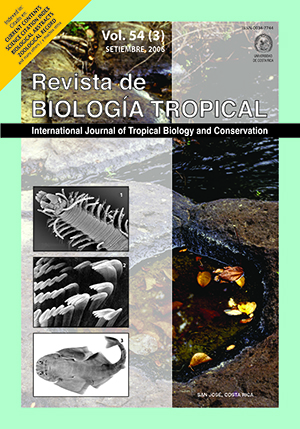Abstract
The mangrove cockle Anadara grandis (Broderip and Sowerby, 1829) is a potential candidate for aquaculture and for bioremediation of aquaculture effluents in the tropical and subtropical coastal areas of the eastern Pacific Ocean. Laboratory-produced spat are available, but there is no information on their responses to the range of environmental conditions to which they might be subject during the growth cycle. The aim of this study was to evaluate the filtration and clearance rates of A. grandis spat (shell length 9.50±0.37 mm) with a food concentration (7.5 mg/L)at four different temperatures (22. 25. 28. 31º C) with pH= 7.5± 2.2 and O2 concentration of 6.4±0.5 mg/L; experiment one); and with a temperature (25º C) and five concentrations of suspended matter (from 7.5 to 29 mg/L and pH and O2 values of 7.9± 0.2 and 6.8± 0.4 mg/L; experiment two). Filtration and clearance rates were highest at 25 ºC and significantly different (p<.05) from those obtained at 22, 28 and 31 ºC; the clearance rates had the same tendency but the differences were not significant (p >.05). In the second experiment filtration increased according to the amount of food available, but there were no significant differences (p>.05) between 7.5 and 11 mg/L and from 22.4 to 29 mg/L. The trend was similar for clearance and in this case significant differences were found (p<.05) between 7.5, 22.4 and 29 mg/L. Filtration at 31 ºC was close to 80% at the optimum temperature of 25 ºC, which indicates that A. grandis is a good candidate for tropical aquaculture. Clearance increased with high concentrations of suspended solids, but the production of biodeposits could be a source of environmental concern. Therefore, the possibility of using this species for bioremediation of aquaculture effluents should be studied with larger specimens and at higher seston concentrations.
##plugins.facebook.comentarios##

This work is licensed under a Creative Commons Attribution 4.0 International License.
Copyright (c) 2006 Revista de Biología Tropical


